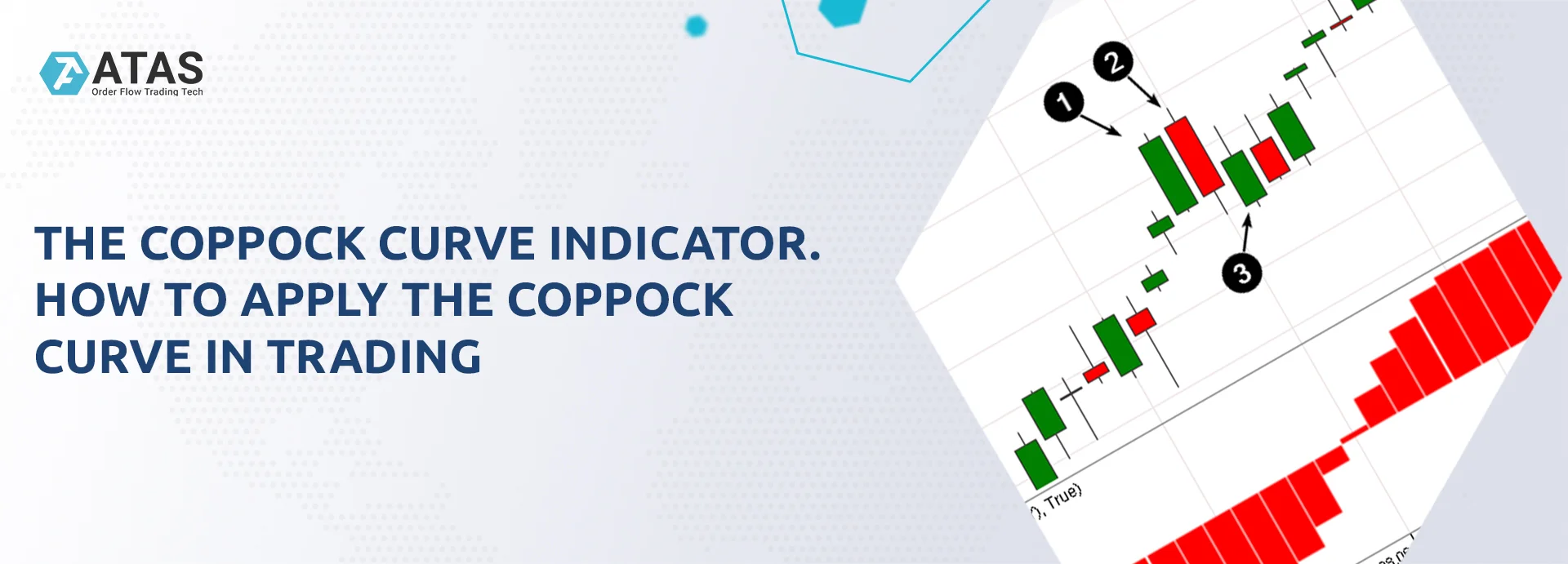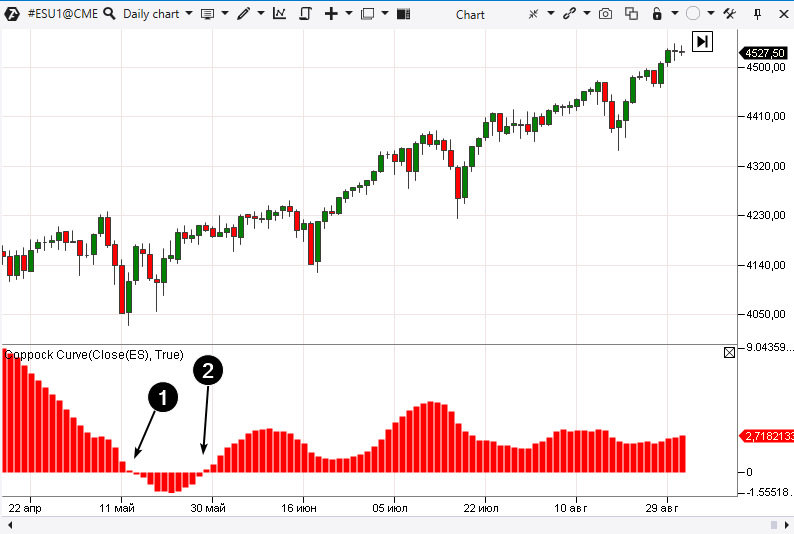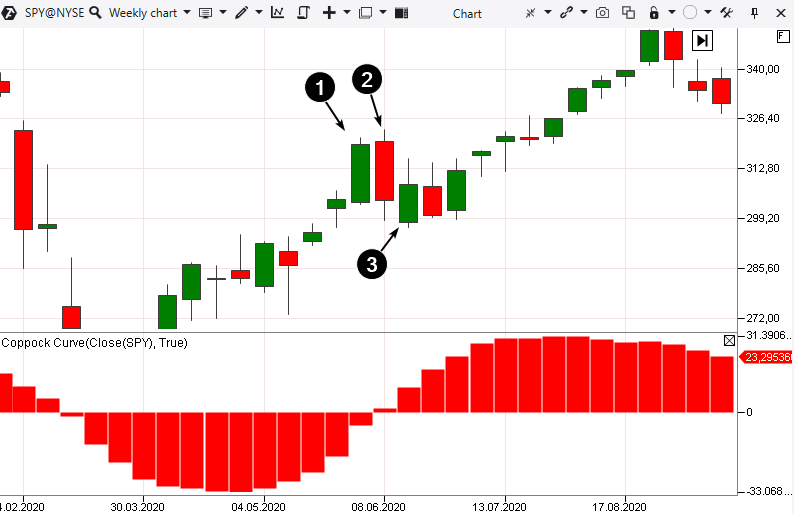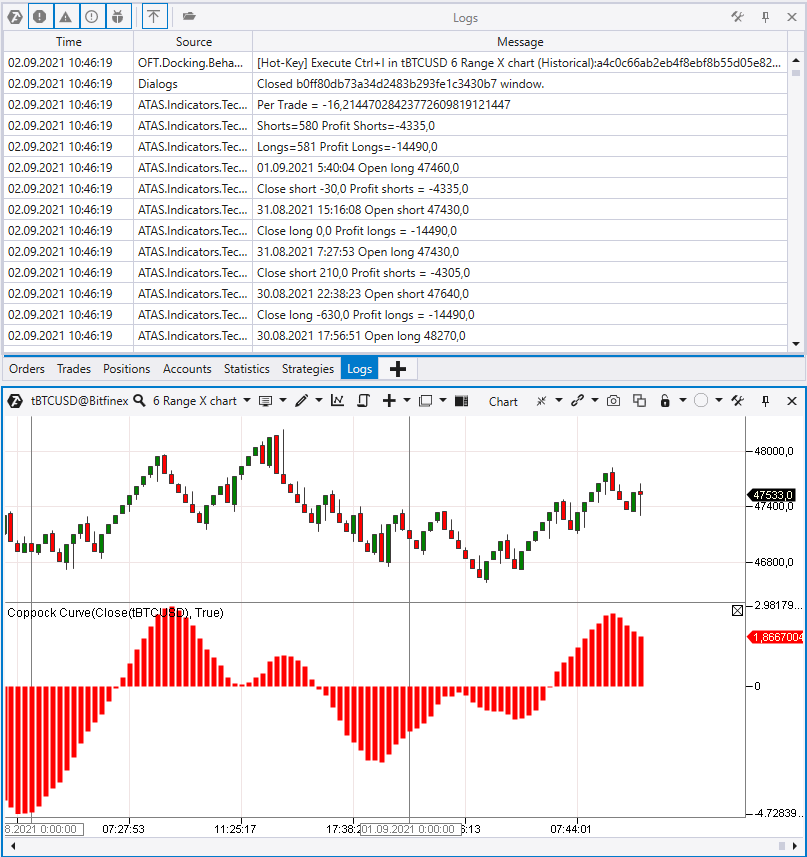The Coppock Curve indicator. How to use it?
Coppock Curve is a momentum indicator. It was developed by Edwin ‘Sedge’ Coppock, who was an economist by education. The original goal of this indicator was to detect long-term opportunities for buying in S&P 500 and Dow Industrials.
However, can it be used for other markets / periods and how profitable are the curve signals?
We will learn it in the present article, which describes:
- the Coppock Curve indicator development history;
- the Coppock Curve indicator signals;
- the calculation formula and settings;
- experiments on assessing trading profitability by Coppock Curve signals;
- advantages and disadvantages;
- comparison of trading by clusters and indicator signals;
- conclusions – what to do in practice.
Brief indicator development history
Coppock presented his indicator in Barron’s magazine in October 1965. It is interesting that the indicator development was carried out upon a request of the Episcopal Church, which was interested in a reliable instrument for long-term investors.
Coppock Curve is a smoothed momentum oscillator. Despite the fact that Coppock developed it for monthly charts, the Coppock Curve indicator can be used on hourly, daily and even minute charts.
The ATAS platform Coppock Curve indicator is in the Technical Indicators section. If you add it to the chart, you will see a wave histogram in the bottom of the window.
The example below is the indicator in the S&P index futures chart.
Indicator signals
The indicator signal is very simple. Coppock used the monthly period data for identification of an opportunity to open a long position, when the indicator moved from the negative territory to the positive one (marked with number 2 in the picture above).
Although Coppock used his curve only to search for buying signals, many technical analysts consider a shift from the positive territory to the negative one (1) as a signal for opening a short position. Thus, the Investors Chronicle, a British investment magazine, uses the Coppock Curve indicator signals for selling, although it underlines the necessity to treat them with caution.
Additional variants of using the indicator:
- entering against a trend on the indicator extreme points (a risky undertaking);
- using divergences.
Calculation formula
The Coppock Curve indicator shows the total rate of change (ROC – Rate of Change) for 14 periods and the rate of change for 11 periods, smoothed by the 10-period weighted moving average.
Read in our Knowledge Base how to set up the indicator.
Edwin Coppock used 11 and 14 months, because, according to an Episcopal Church priest, it was the average mourning period when someone grieved for the loss of a beloved one. Coppock assumed that the period of the stock market loss recovery was similar to this period.
In order to find out how profitable the indicator signals are, we developed a simple algorithm, which can be connected to the ATAS platform via API as a custom indicator, in the Microsoft Visual Studio, using the C# programming language.
- The How to code algorithms for ATAS article explains in simple words how to do it.
- You can find examples of the Super Trend indicator signal testing in this article.
The algorithm logic is shown in the chart below.
- The bullish ‘i-1’ candle. The indicator is still below zero on this candle.
- The bearish ‘i’ candle. The indicator has already moved to the positive territory on the candle closing. It is a buy signal.
- The ‘i+1’ candle opening price is the price of entering into a long.
Experiments
Experiment 1. Let’s see how Coppock Curve operates in the Continuous futures (ES) chart with the 4-hour period.
The algorithm calculated that 308 long trades and 307 short trades had been executed during 2000 days by the signals of the Coppock Curve indicator crossing the zero line. The total result was 1,637.25 – 1,041.25 = USD 596.
You need to take into account here that USD 1 in the ES chart means 4 ticks at USD 12.5 each, and the commission is USD 5.5 per cycle.
Then the real result is 596 * 4 * 12.5 – (308 + 307) * 5.5 = 29,800 – 3,382.5 = 26,417.5 without regard to possible slippages.
The result is positive, however, we should note that:
- Simple holding is more profitable than active trading by the indicator signals.
- The market was in the state of steady growth in the chart under consideration. The indicator gives worse results in a flat.
Let’s see what results will be, if we switch from a stock index to, for example, cryptocurrencies and change the chart.
Experiment 2. Let’s add the algorithm to the Range X chart (period = 6, Scale = 150) of the Bitcoin price for the period of 150 days with the Bitfinex exchange data.
The algorithm calculated that 581 long and 580 short trades were executed during the period under consideration by the signals of the Coppock Curve indicator crossing the zero line. Losses were made in both directions. The average result of a trade was minus USD 16 when trading BTC 1 regardless of the commission.
If we ‘turn over’ the strategy and sell by the buying signals and buy by the selling signals, we will not be able to make money anyway, because the commission fees will ‘eat up’ the trade yield.
Perhaps, you also had a thought: what will happen, if we buy at lows and sell at highs, which are formed by the Coppock Curve indicator?
Experiment 3. We modify the code and ‘launch’ it to the chart.
When the curve forms a low (1), the algorithm executes a buy trade at the opening price (3) on the next candle opening (2). That is why we see in the logs that the long trade (4), which was opened on September 1 at 02:28:33 and closed on the same day at 19:02:24, brought significant USD 1,650 of profit without regard to the commissions.
However, everything falls into place, if we look at the data for 250 days (5). The average result from 1,403 buys and 1,402 sells equals plus USD 9 per trade only when trading BTC 1. Mathematical expectation is positive, but it is very close to zero.
We got similar results when we added the algorithm to other charts, while experimenting with instruments, chart types and periods.
Conclusions with respect to the experiments. It seems that the Coppock Curve indicator is able to produce profit under conditions of a steady trend in the stock market. However, the result slightly deviates from random trades in other cases.
Advantages and disadvantages of the Coppock Curve indicator
The Coppock Curve indicator has the same advantages and disadvantages as many other technical indicators have.
Advantages:
- simple signals, which can help you to build a mechanical strategy easily;
- it allows catching big trends;
- it doesn’t redraw.
Disadvantages:
- a big number of false signals;
- trading by the indicator signals doesn’t allow you to count on a serious profit.
Does it make sense to use the Coppock Curve indicator?
The above collected statistics doesn’t mean that the indicator is completely useless. Rely on Coppock Curve only if you are sure that the indicator brings you more good than bad.
We recommend you to read more about cluster charts in order to execute more profitable trades.
The ATAS platform allows you to work with 25 variants of clusters.
Let’s consider an example of how the ability to read clusters can help you in trading in the GBP futures market, and what the Coppock Curve indicator shows in this case. The screenshot below shows the futures tick chart (ticks = 500, scale = 1), and the data are taken from the CME.
Number 1 marks a bright red cluster, which testifies to the emergence of sellers’ pressure. As a result, the price falls, and the bar is closed at a low.
Then, the price dynamics testifies to the bearish momentum weakening during several bars, while the Delta changes its values from negative to positive (number 2). This is the first sign of the market character change.
Number 3 points to buyers’ attack – there is a bright green cluster of the buyers’ activity in the lower part of the bar and, as a result, this activity made the bar close at its highs. It is a clear bullish signal.
The upward momentum continued at the next bar (4), where we can see formation of a bright buying cluster. If we draw a horizontal line from this cluster, it will often serve as the support level, which happened in our case.
Further, the price increased during the day, and if the cluster chart readers had opened longs on candles 3 and 4, they could have accumulated profit by this position.
Note the Coppock Curve indicator values. Number 5 points to an early buying signal when a low was formed. Number 6 points to a classical buying signal when the indicator moves from the negative territory to the positive one. Both signals come with a delay if compared with the buyers’ activity signals, which we can see in cluster charts.
Comparing Coppock Curve and Market Profile
Let’s add the Coppock Curve indicator and daily profiles to an hourly GBP futures chart. The chart covers the market period of September 8-15, 2021. A bullish resistance breakout took place and a range between 1,3800 and 1,3880 was formed in the market during this period.
What signals did the Coppock Curve and Market Profile indicators send?
The Coppock Curve indicator was rather accurate there, sending a long signal on the boundary between September 8 and 9 (2). The position moved into the positive territory on Thursday September 9 after a certain drawdown.
How did the Market Profile send a buying signal? Note that a range between 1,3755 and 1,3780 was formed on September 8, and the downward exit (3) from this range failed. It marked an increase in chances that the price would exit from the September 8 range up, which took place on September 9. Buying at the upper boundary brought approximately the same result as buying by the Coppock Curve indicator.
So, the score is even here – 1:1.
Trading in a range
As you can see, the Coppock Curve sends false signals under flat conditions.
However, if you read the Market Profile, you can find entry levels with high accuracy. How? Note that a thin profile was formed when a breakout took place (marked with circle 4). Demand completely exceeded supply, that is why a return to the thin profile territory (near 1,3800) sent a signal to consider an entry into a long ‘on a bounce’. These signals turned out to be true on September 13 and 15.
A more detailed application of the profile is presented in the following article with video: Trading by disbalance levels.
The profile has the advantage under flat conditions. The final ‘score’ is 2:1 in favour of the Market Profile. Of course, application of the horizontal volume requires knowledge and experience, but you have the ATAS blog for traders and demo account service. Everything is in your hands!
Conclusions
The Coppock Curve was developed more than 50 years ago, and it represents a simple smoothed momentum oscillator. The Rate of Change indicator measures the momentum, while the Weighted Moving Average smooths down the data.
Our statistics collection experiments show that analysts can make certain efforts and set up the Coppock Curve indicator so that it can provide at least some mathematical advantage in the long run. However, it’s highly likely that it will be ‘eaten up’ by commissions and slippages.
If you feel comfortable trading by the Coppock Curve, you can add it to the chart in the ATAS platform. However, in order to increase profitability of your trading, we recommend you to use the functionality of modern cluster analysis and advanced indicators, which operate with prime causes of price movements.
Download the ATAS platform free of charge and compare how more efficient cluster charts can be in comparison with classical indicators.
Information in this article cannot be perceived as a call for investing or buying/selling of any asset on the exchange. All situations, discussed in the article, are provided with the purpose of getting acquainted with the functionality and advantages of the ATAS platform.











